PBS News: December 25 – 30, 2019, Mysterious death of White Helmets co-founder spotlights toxic propaganda, China: Power and Prosperity — Watch the full documentary
TED Talks: Cara E Yar Khan The beautiful balance between courage and fear, Katie Hinde What we don’t know about mother’s milk and Kate Slabosky The three different ways mammals give birth
WIRED UK: Shenzhen – The Silicon Valley of Hardware (Full Documentary)
Scientific American: A Russian Ice Cap Is Collapsing–It Could Be a Warning
NASA’s Giant Leaps, Past and Future: Saluting Apollo Heroes and Looking Forward to Artemis Missions, SpaceX #CrewDragon Demonstration Flight Return to Earth
Thisiscolossal: Radically Diverse Australian Fungi Photographed by Steve Axford, Wildlife Intertwine in Finely Rendered Mythological Worlds by Lauren Marx, Unsettling Illustrations of Tangled Flora and Fauna Beings by Alex Kuno, and Wildlife Intertwine in Finely Rendered Mythological Worlds by Lauren Marx
EcoFarmVideo: Mushrooms, Mycology of Consciousness – Paul Stamets, EcoFarm Conference Keynote 2017,
PBS NewsHour full episode, Dec 30. 2019
Dec 30, 2019 PBS NewsHour
Monday on the NewsHour, weekend attacks on Jewish and Christian congregations send shockwaves nationwide, reiterating fears of violence toward religious groups. Plus: The fallout from U.S. airstrikes on an Iran-backed militia group in Iraq, 2020 Democrats campaign in Iowa and New Hampshire, Politics Monday with Susan Page and Domenico Montanaro and our Now Read This book club for December. Stream your PBS favorites with the PBS app: https://to.pbs.org/2Jb8twG Find more from PBS NewsHour at https://www.pbs.org/newshour Subscribe to our YouTube channel: https://bit.ly/2HfsCD6
PBS NewsHour Weekend full episode December 29, 2019
Dec 29, 2019 PBS NewsHour
On this edition for Sunday, December 2019, a suspect was arraigned in the stabbing attack that injured five people during a Hanukkah celebration at a rabbi’s home in New York. Also, NewsHour Weekend producers and reporters discuss some of their biggest stories in 2019. Karina Mitchell anchors from New York. Stream your PBS favorites with the PBS app: https://to.pbs.org/2Jb8twG Find more from PBS NewsHour at https://www.pbs.org/newshour Subscribe to our YouTube channel: https://bit.ly/2HfsCD6
PBS NewsHour Weekend full episode December 28, 2019
Dec 28, 2019 PBS NewsHour
On this edition for Saturday, December 28, a truck bombing in Mogadishu, Somalia, killed at least 78 people and injured more than 120 others, and how winter storms across the southeast and plains are affecting travel this holiday weekend. Also, NewsHour Weekend producers and reporters reflect on some of their favorite stories from 2019. Karina Mitchell anchors from New York. Stream your PBS favorites with the PBS app: https://to.pbs.org/2Jb8twG Find more from PBS NewsHour at https://www.pbs.org/newshour Subscribe to our YouTube channel: https://bit.ly/2HfsCD6
PBS NewsHour full episode, Dec 27, 2019
Dec 27, 2019 PBS NewsHour
Friday on the NewsHour, how Iran is responding to internal pressure from mass protests and external pressure from U.S. sanctions. Plus: What the outcry over a new Indian citizenship law says about the country’s secular values, Mark Shields and David Brooks review the politics of 2019 and preview 2020 and a new film imagines the interactions between Popes Benedict and Francis. Stream your PBS favorites with the PBS app: https://to.pbs.org/2Jb8twG Find more from PBS NewsHour at https://www.pbs.org/newshour Subscribe to our YouTube channel: https://bit.ly/2HfsCD6
PBS NewsHour full episode, Dec 26, 2019
Dec 26, 2019 PBS NewsHour
Thursday on the NewsHour, how months of mass protest have contributed to political gridlock in Iraq. Plus: Why U.S. territories in the Caribbean are still recovering from 2017 hurricanes, Zimbabwe’s worsening food crisis, experimentation in the economics of development, a critically acclaimed memoir, rare J.M.W. Turner watercolors on display and a Brief But Spectacular take on Beach Boy life. WATCH TODAYS SEGMENTS News Wrap: Hong Kong protesters target shopping malls again https://www.youtube.com/watch?v=Kgbx2… Why Iraq has been unable to find a new prime minister https://www.youtube.com/watch?v=UHLX_… Why hurricane recovery in U.S. islands remains underfunded https://www.youtube.com/watch?v=pGPco… In Zimbabwe, 60 percent of the population is food insecure https://www.youtube.com/watch?v=rufQk… How these 2 Nobel winners are challenging popular economics https://www.youtube.com/watch?v=tXFiT… Sarah Broom on ‘The Yellow House’ and New Orleans East https://www.youtube.com/watch?v=VtdAI… Watercolors of J.M.W. Turner make rare appearance in U.S. https://www.youtube.com/watch?v=b3_J5… Mike Love’s Brief But Spectacular take on Beach Boy life https://www.youtube.com/watch?v=-xoHa… Stream your PBS favorites with the PBS app: https://to.pbs.org/2Jb8twG Find more from PBS NewsHour at https://www.pbs.org/newshour Subscribe to our YouTube channel: https://bit.ly/2HfsCD6
PBS NewsHour full episode December 25, 2019
Dec 25, 2019 PBS NewsHour
Wednesday on the NewsHour, as the year concludes, we examine what it told us about the problem of climate change — and how to address it. Plus: How foreign policy has evolved over the past decade, repairing Notre Dame Cathedral after a devastating fire, late night TV with Lilly Singh, a conversation with “The Other Americans” author Laila Lalami and military musicians sing “Carol of the Bells.” Stream your PBS favorites with the PBS app: https://to.pbs.org/2Jb8twG Find more from PBS NewsHour at https://www.pbs.org/newshour Subscribe to our YouTube channel: https://bit.ly/2HfsCD6
Mysterious death of White Helmets co-founder spotlights toxic propaganda
Dec 24, 2019 PBS NewsHour
A month after the suspicious death of White Helmets co-founder James Le Mesurier in Turkey, British officials are being urged to conduct a thorough investigation of the incident. Friends and colleagues fear Le Mesurier may have been murdered or driven to suicide by a relentless campaign of character assassination. Special correspondent Malcolm Brabant reports on how propaganda maligned him. Stream your PBS favorites with the PBS app: https://to.pbs.org/2Jb8twG Find more from PBS NewsHour at https://www.pbs.org/newshour Subscribe to our YouTube channel: https://bit.ly/2HfsCD6
After being diagnosed with a rare genetic condition that deteriorates muscle, Cara E. Yar Khan was told she’d have to limit her career ambitions and dial down her dreams. She ignored that advice and instead continued to pursue her biggest ambitions. In this powerful, moving talk, she shares her philosophy for working on the projects that matter to her most — while letting courage and fear coexist. Watch for heart-stopping, vertigo-inducing footage of a trip that shows her living her theory to the full.
This talk was presented at an official TED conference, and was featured by our editors on the home page.
About the speaker
Cara E. Yar Khan · Human rights and disability activist
Breast milk grows babies’ bodies, fuels neurodevelopment, provides essential immunofactors and safeguards against famine and disease — why, then, does science know more about tomatoes than mother’s milk? Katie Hinde shares insights into this complex, life-giving substance and discusses the major gaps scientific research still needs to fill so we can better understand it.
This talk was presented at an official TED conference, and was featured by our editors on the home page.
About the speaker
Katie Hinde · Lactation researcher
TEDWomen 2016 | October 2016
What inspires you?
Tell us your interests and we’ll pick TED Talks just for you.
All mammals share certain characteristics, like warm blood and backbones. But despite their similarities, these creatures also have many biological differences — and one of the most remarkable differences is how they give birth. Kate Slabosky details the placental, marsupial, and monotreme methods of giving birth. [Directed by Compote Collective, narrated by Julianna Zarzycki, music by Big Banda Soundscapers].
Meet the educator
Kate Slabosky · Educator
About TED-Ed
TED-Ed Original lessons feature the words and ideas of educators brought to life by professional animators.
TED-Ed | April 2017
Shenzhen: The Silicon Valley of Hardware (Full Documentary) | Future Cities | WIRED
Jul 5, 2016 WIRED UK
Future Cities, a full-length documentary strand from WIRED Video, takes us inside the bustling Chinese city of Shenzhen. Subscribe to WIRED?? https://po.st/SubscribeWired We examine the unique manufacturing ecosystem that has emerged, gaining access to the world’s leading hardware-prototyping culture whilst challenging misconceptions from the west. The film looks at how the evolution of “Shanzhai” – or copycat manufacturing – has transformed traditional models of business, distribution and innovation, and asks what the rest of the world can learn from this so-called “Silicon Valley of hardware”. ABOUT FUTURE CITIES Future Cities is part of a new flagship documentary strand from WIRED Video that explores the technologies, trends and ideas that are changing our world. Subscribe to the WIRED YouTube channel to ensure you never miss an episode. HOLY LAND: STARTUP NATIONS (SERIES 2) Premiering in February, the second season of WIRED’s Future Cities series takes us inside one of the world’s biggest startup nations. With the most tech startups and venture capital per capita in the world, Israel has long been hailed as The Startup Nation. WIRED’s four-part series will look beyond Tel Aviv’s vibrant, liberal tech epicentre to the wider Holy Land region – the Palestinian territories, where a parallel Startup Nation story is emerging in East Jerusalem, Ramallah and the West Bank, as well as in the Israeli cybersecurity hub of Beersheba. And we will learn how the fertile innovation ecosystem of Silicon Wadi has evolved as a result of its unique political, geographical and cultural situation and explore the future challenges – and solutions – these nations are facing. CONNECT WITH WIRED Web: https://po.st/WiredVideo Twitter: https://po.st/TwitterWired Facebook: https://po.st/FacebookWired Google+: https://po.st/GoogleWired Instagram: https://po.st/InstagramWired Magazine: https://po.st/MagazineWired Newsletter: https://po.st/NewslettersWired ABOUT WIRED WIRED brings you the future as it happens – the people, the trends, the big ideas that will change our lives. An award-winning printed monthly and online publication. WIRED is an agenda-setting magazine offering brain food on a wide range of topics, from science, technology and business to pop-culture and politics.
Category Science & Technology
A Russian Ice Cap Is Collapsing–It Could Be a Warning
A surge in glacial ice flow that created an “ice stream” is a concern for Greenland and Antarctica as well
By Chelsea Harvey, E&E News on December 23, 2019
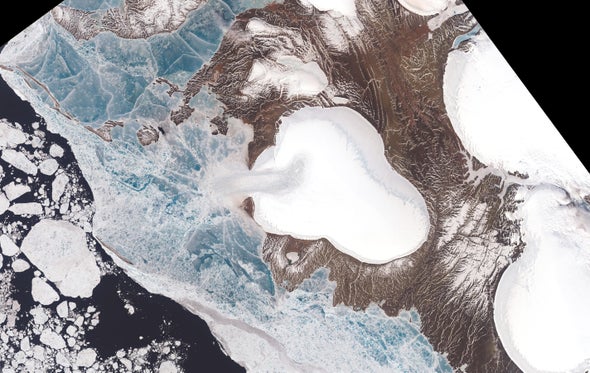
Vavilov ice cap, June 24, 2018. Credit: NASA Earth Observatory
High in the Russian Arctic, in the
chilly waters straddling the Kara and Laptev, an 84-billion-ton island ice cap
is projectile vomiting into the sea. Scientists say it could hold useful clues
about what to expect as the world continues to warm.
The Vavilov Ice Cap, nestled in Russia’s Severnaya Zemlya archipelago, suddenly
started to surge forward in 2013. This is not an uncommon event for glaciers —
every so often, pressure will build up behind the ice and cause it to
temporarily slip forward. These surge events can last anywhere from a few
months to a year or more, and they’ll typically stabilize on their own.
But in 2015 — two years after the surge started — the Vavilov Ice Cap was still
going. By then, it was moving faster than ever, flowing forward at a rate of
about 26 meters per day and dumping 4.5 billion tons of ice into the sea over
the course of a single year.
In total, Vavilov has lost about 9.5 billion tons of ice in the last six years.
Scientists monitoring the ice cap’s progress say it’s moved beyond a simple
glacial surge. The rush of ice seems to have transitioned into a phenomenon
known as an “ice stream,” a long-lasting, fast-moving flow of ice out
of the glacier and into the surrounding landscape — or, in this case, the sea.
Scientists know ice streams exist in frozen places around the world, including
the Greenland and Antarctic ice sheets. But according to a new paper
describing the events at Vavilov, this is the first time researchers have
documented an ice stream’s formation from the very beginning.
Now that they’ve seen how it happens, the researchers say their observations
may hold clues about the future of the world’s glaciers as global temperatures
rise.
“Now we know these ice caps could be more unstable” than previously
believed, said lead study author Whyjay Zheng, a doctoral student at Cornell
University. “We may possibly have to revise our future sea-level rise,
considering this.”
Even when they appear to be stationary, glaciers are typically flowing forward
— just so slowly it’s barely noticeable. There’s a reason for the phrase
“moving at a glacial pace.” Until 2013, Vavilov Ice Cap was likely
inching forward at an imperceptible rate.
The researchers believe the ice first began to surge when it pushed past a
mound of sediment on the landscape that had previously served as a barrier
holding it back. When this happened, it slid onto a smoother patch of bedrock
and slipped forward.
“You used to have a gate that constrained the ice, and then you lose this
gate,” Zheng said. “So all of this ice at a higher place just
collapsed down into the ocean.”

Over time, as the movement of the
ice accelerated, the scientists began to observe physical features that
suggested the flow had morphed into an ice stream. Rifts and crevasses began to
appear on the landscape around the moving ice, which showed up as dark stripes
on satellite images. These cracks are typical features of ice streams.
While warming didn’t necessarily cause the initial surge, the researchers
believe rising temperatures may be partly influencing the flow of ice, now that
it’s on the move. During hotter summers — including unusually warm years in
2015 and 2018 — the researchers observed that the ice tended to flow even
faster, slowing down again when the temperatures cool.
The scientists haven’t proved the temperatures are causing the faster ice flow,
but they suspect there’s a connection. If so, it could mean even faster losses
at Vavilov Ice Cap as the region warms.
Perhaps more importantly, the ice cap’s behavior has given scientists useful
insight into the factors that cause ice streams to form in the first place. In
Vavilov’s case, a shift in the bedrock beneath the ice seems to have been a key
component. Afterward, faster ice flow seems to have helped the initial surge
transform into a long-lasting, possibly permanent ice stream.
Scientists believe the much larger Greenland and Antarctic ice sheets may be
vulnerable to these kinds of processes as temperatures rise.
Ocean-facing glaciers in Greenland and Antarctica are often stabilized by thick
ledges of ice, or ice shelves, jutting out into the sea. A theory known as
“marine ice sheet instability” suggests that as ice shelves melt and
weaken, glaciers may begin to slip backward along the bedrock beneath them,
pouring ice into the ocean at faster speeds. Eventually, they may give way to
unstoppable losses, which may empty entire glaciers into the sea.
While Vavilov is a comparatively tiny patch of ice, it’s demonstrated similar
processes in action, the researchers say. A stabilizing barrier broke down and
allowed the ice to surge forward. The ice never stabilized, and it’s now become
a fast-flowing ice stream.
What this means for the future of the Vavilov Ice Cap remains uncertain. It’s
still too early to tell whether the stream will slow down again — or, in a
worst case scenario, eventually drain the ice cap from the face of the island.
“One thing we have to do is to continue to monitor this place,” Zheng
said. “Maybe for 10 more years or so.”
Reprinted from ClimateWire with permission from E&E News. E&E
provides daily coverage of essential energy and environmental news at www.eenews.net.
ABOUT THE AUTHOR(S)
Chelsea Harvey
Recent Articles
- Millions of Birds Are Migrating Earlier Because of Warming
- Maps That Peer Below Antarctic Ice Show Precarious Position of Key Glacier
- More and More Links Are Emerging between Warming and Extreme Weather
China: Power and Prosperity — Watch the full documentary
Nov 22, 2019 PBS NewsHour
As China has risen in prosperity, influence and military strength, what are the social, economic and political forces at play? Come along with PBS NewsHour as we travel around the globe to explore the emerging superpower and its relationship with the United States. “China: Power and Prosperity” covers the country’s powerful leader, his signature foreign policy, U.S.-China trade and technology wars, how Chinese technology helps stifle dissent, and more. A collaboration with the Pulitzer Center on Crisis Reporting, PBS NewsHour conducted more than 70 on-camera interviews in eight Chinese cities and across eight countries. Stream your PBS favorites with the PBS app: https://to.pbs.org/2Jb8twG Find more from PBS NewsHour at https://www.pbs.org/newshour Subscribe to our YouTube channel: https://bit.ly/2HfsCD6
NASA’s Giant Leaps, Past and Future: Saluting Apollo Heroes and Looking Forward to Artemis Missions,
Streamed live on Jul 19, 2019 NASA
Fifty years ago, humans took their first steps on the Moon and the world watched as we made history. On July 19, 2019, we broadcast this live salute to our #Apollo50th heroes and looked forward to our next giant leap for future #Artemis missions to the Moon and Mars.
Category Science & Technology
SpaceX #CrewDragon Demonstration Flight Return to Earth
Streamed live on Mar 8, 2019 NASA
Join us starting at 7:30 a.m. EST to see SpaceX’s #CrewDragon on its journey back to Earth, including its deorbit burn and splashdown in the Atlantic Ocean.
Category Science & Technology
Radically Diverse Australian Fungi Photographed by Steve Axford
May 27, 2015 Christopher Jobson
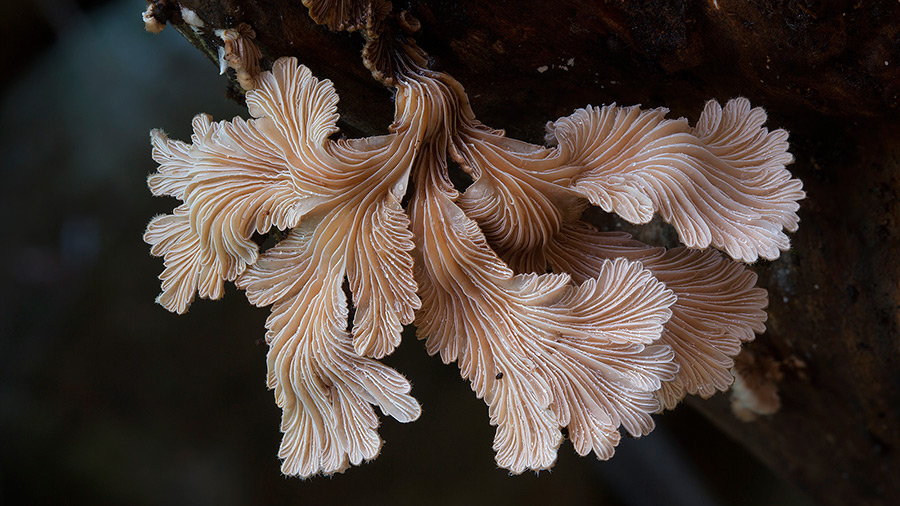
Photographer Steve Axford (previously) continues his quest to document some of the world’s most obscure fungi found in locations around Australia. Axford lives and works in the Northern Rivers area of New South Wales in Australia where he often has to travel no further than his own back yard to make some of the discoveries you see here. The forms of fungi, slime molds, and lichens he prefers to document seem to have no limit in their diverse characteristics. Axford explained when we first featured his work last year that he suspects many of the tropical species he stumbles onto are often completely undocumented. You can follow more of Axford’s discoveries on Flickr and SmugMug.
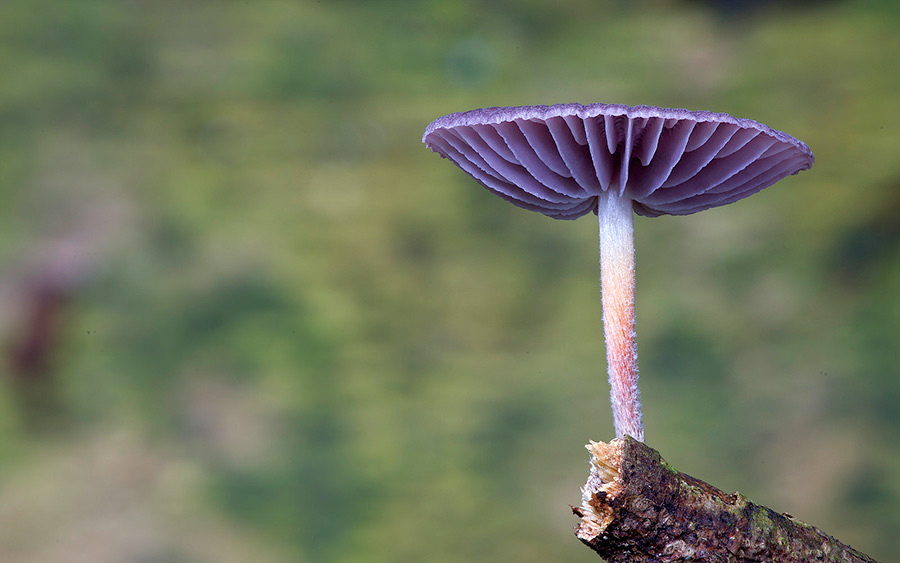
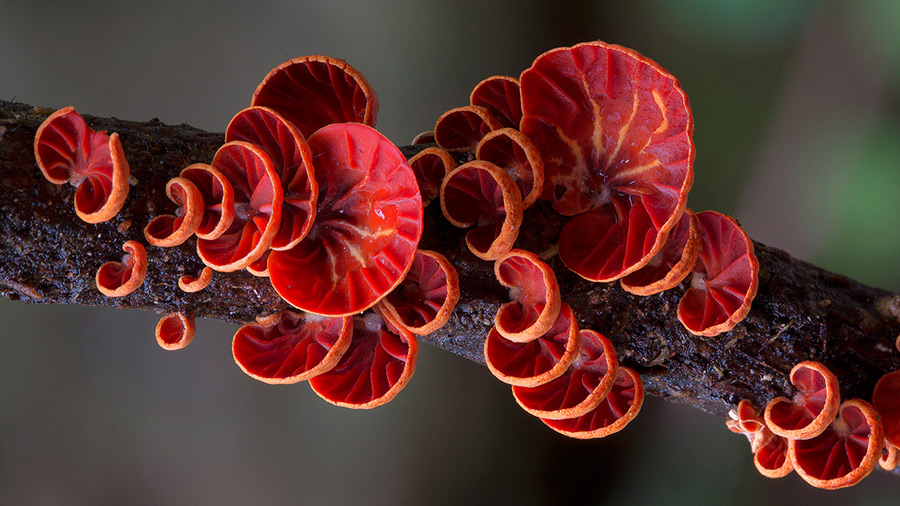
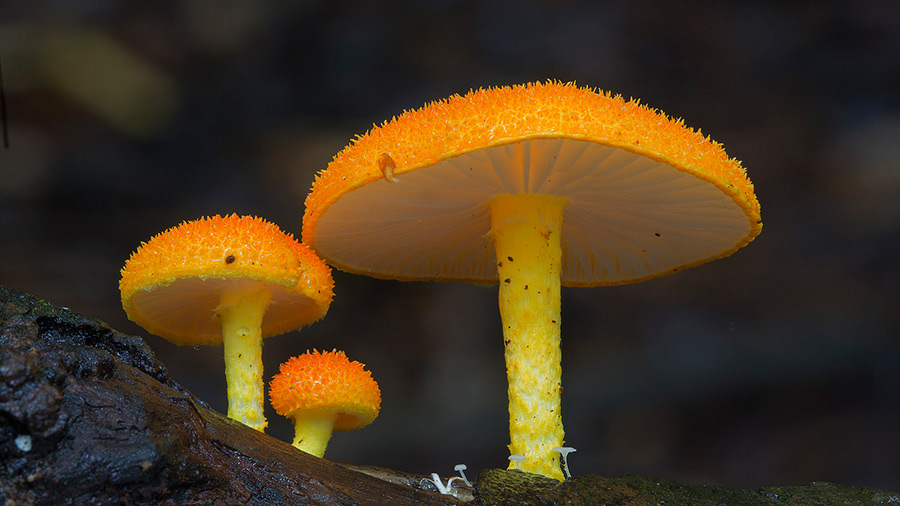
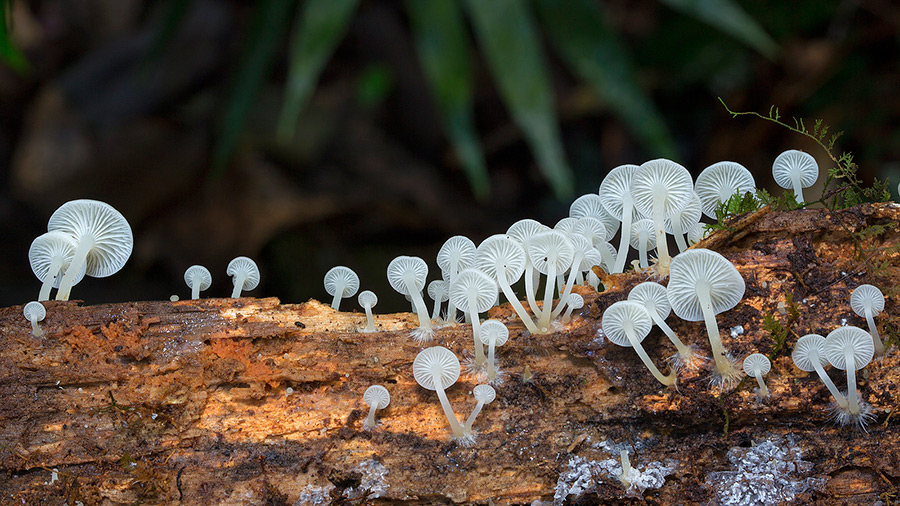
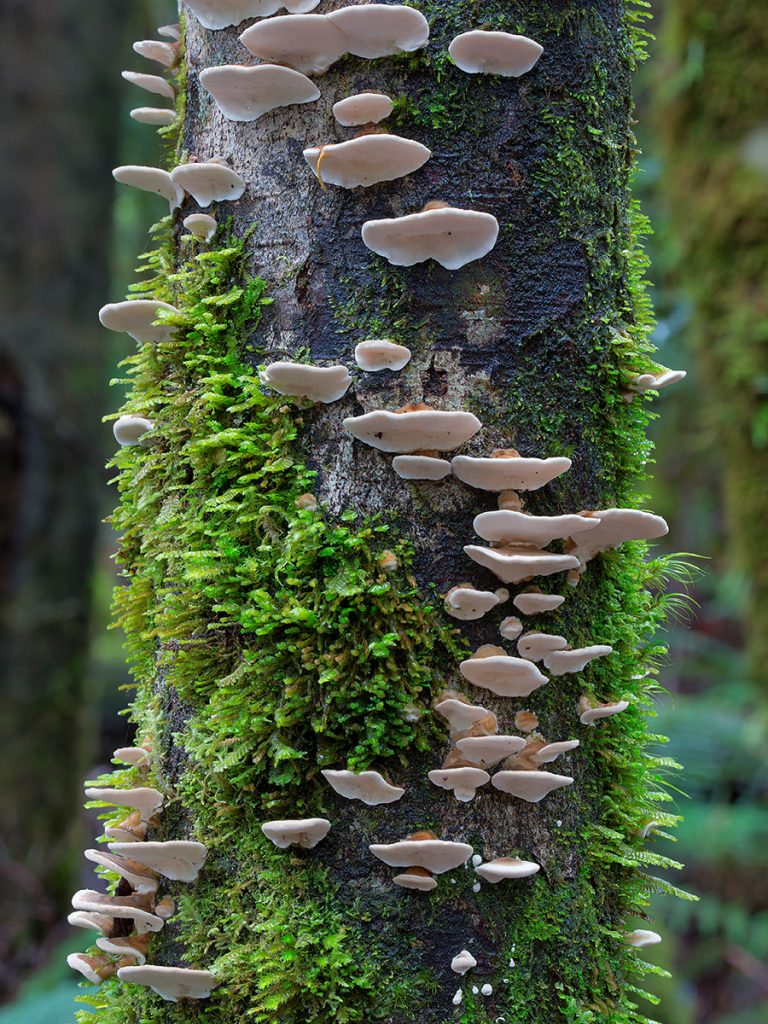
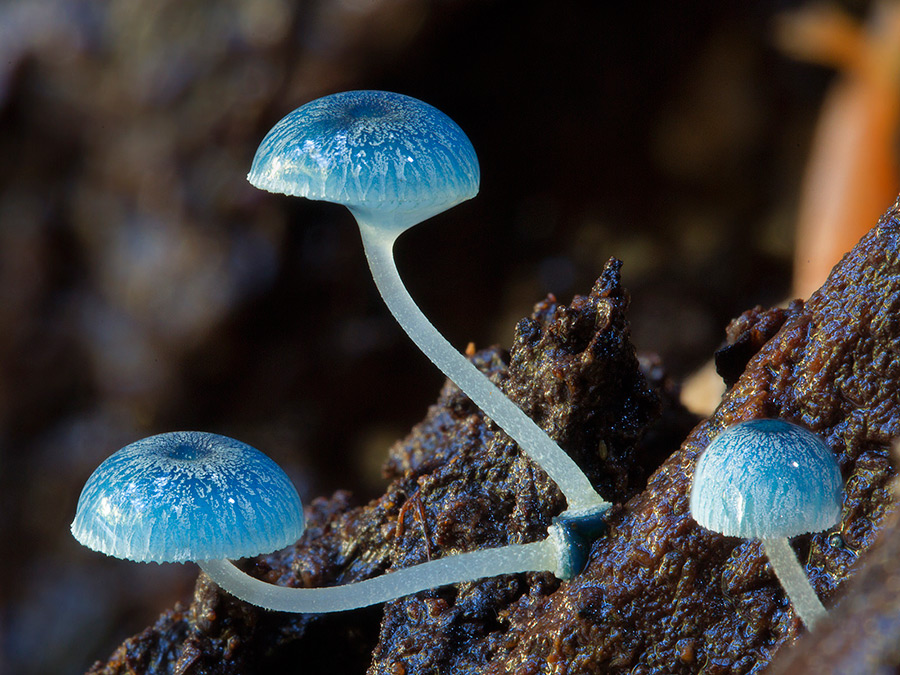
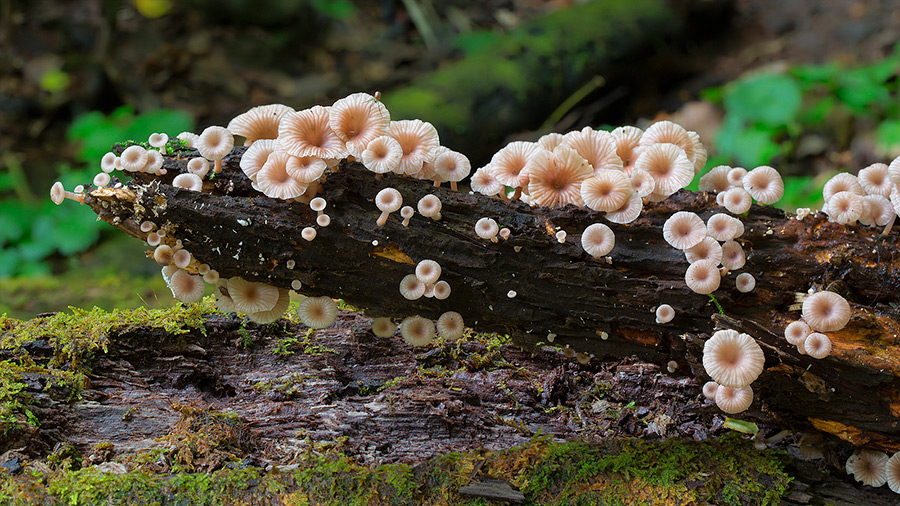
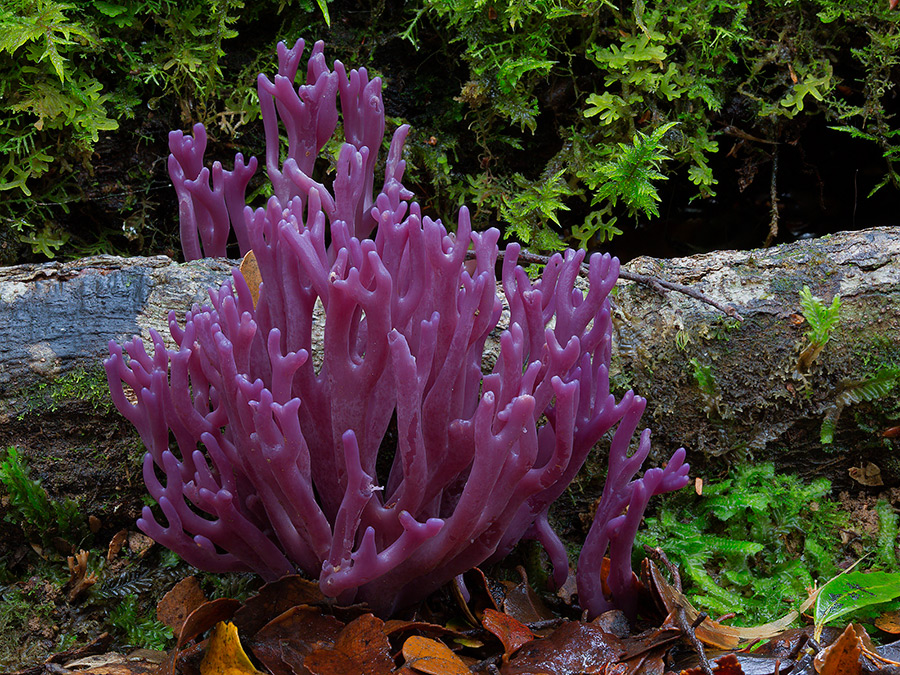

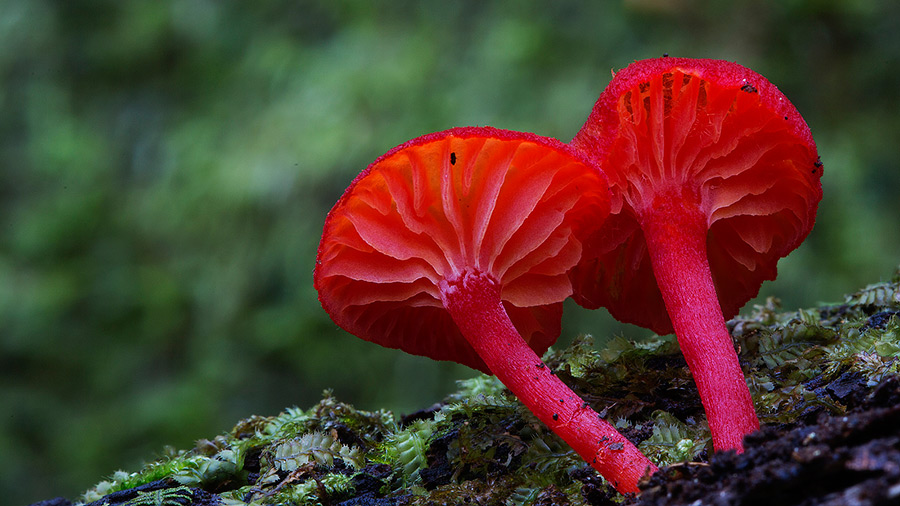
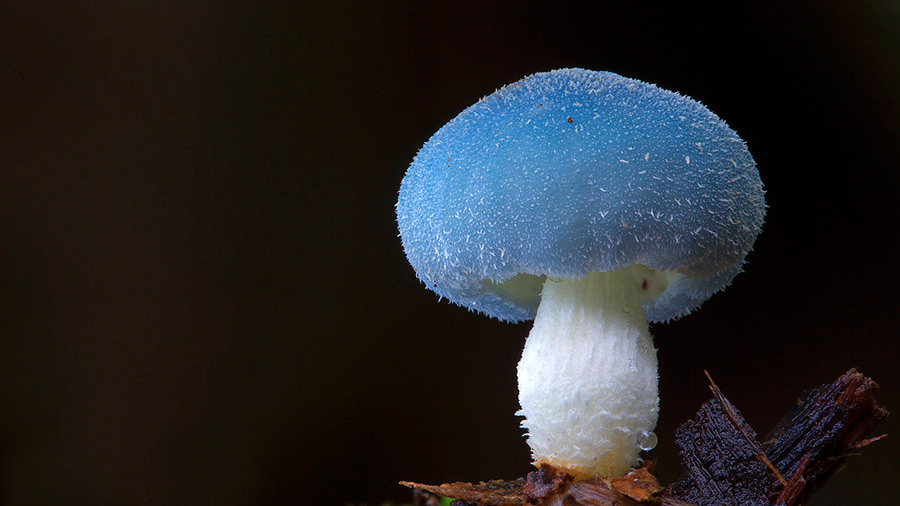
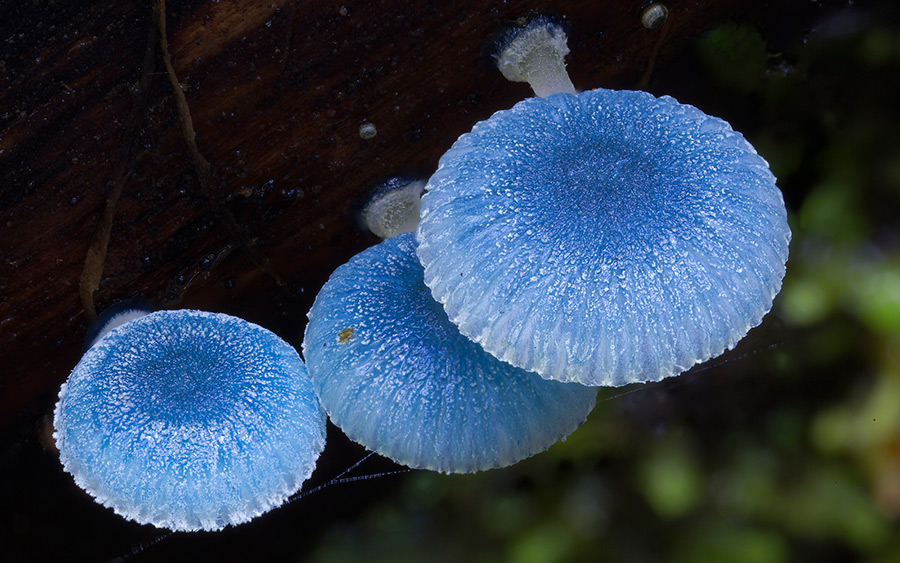
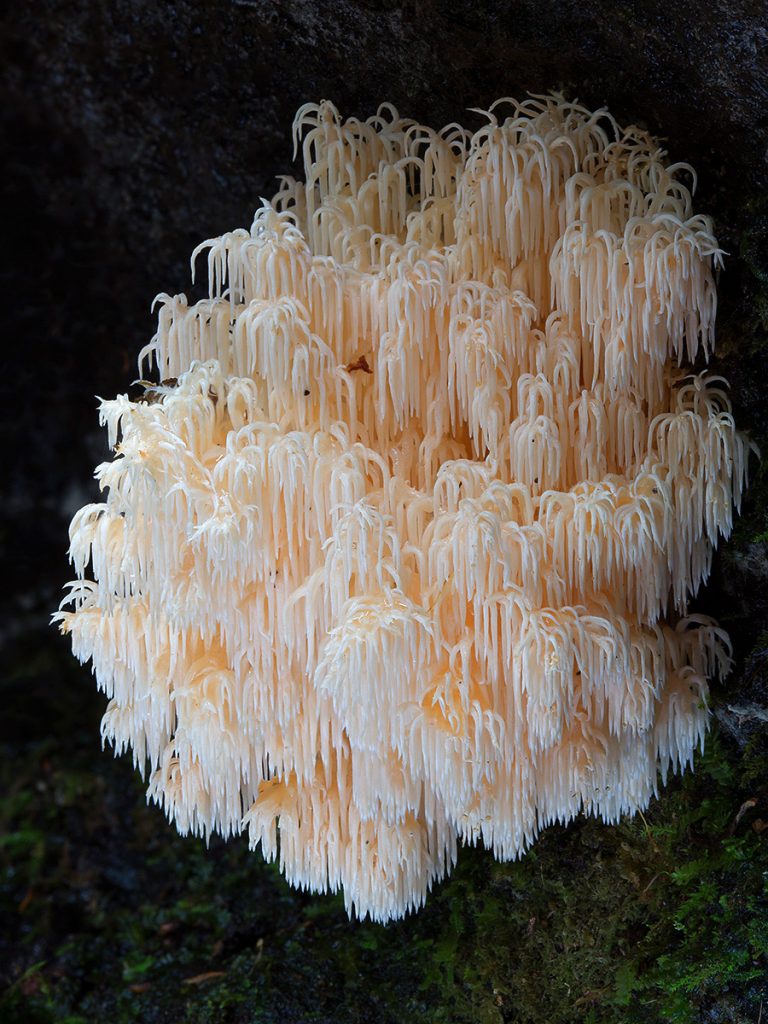
Mushrooms, Mycology of Consciousness – Paul Stamets, EcoFarm Conference Keynote 2017
Feb 16, 2017 EcoFarmVideo
EcoFarm Conference “Mycodiversity is our biosecurity. Let’s celebrate decomposition. Let’s let it rot.” Paul Stamets, speaker, author, mycologist, medical researcher and entrepreneur, is considered an intellectual and industry leader in fungi habitat, medicinal use, and production. He lectures extensively to deepen your understanding and respect for the organisms that literally exist under every footstep you take on this path of life. His presentations cover a range of mushroom species and research showing how mushrooms can help the health of people and planet. His central premise is that habitats have immune systems, just like people, and mushrooms are cellular bridges between the two. Our close evolutionary relationship to fungi can be the basis for novel pairings in the microbiome that lead to greater sustainability and immune enhancement. www.eco-farm.org
Category Nonprofits & Activism
Unsettling Illustrations of Tangled Flora and Fauna Beings by Alex Kuno
March 8, 2017 Christopher Jobson
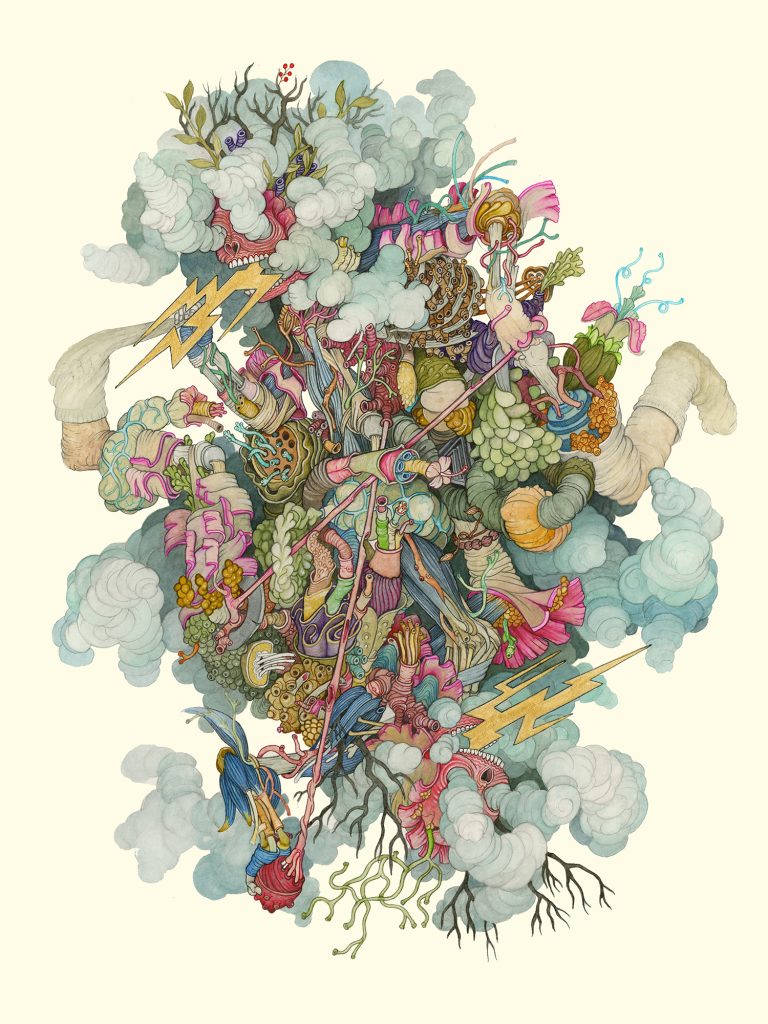
Minneapolis-based artist Alex Kuno imagines a world of twisted organic beings that borrow elements of plant life, anatomy, and the natural world. The artist admits that his illustrations are likely to creep some people out, but purposefully includes ideas that highlight life and growth, creating a dichotomy of revulsion and delight as the viewer carefully untangles each artwork. The mixed-media drawings are made primarily using ink, watercolor, graphite and chalk. You can see more of Kuno’s artwork on Instagram and limited edition prints are available in his shop. (via Booooooom)
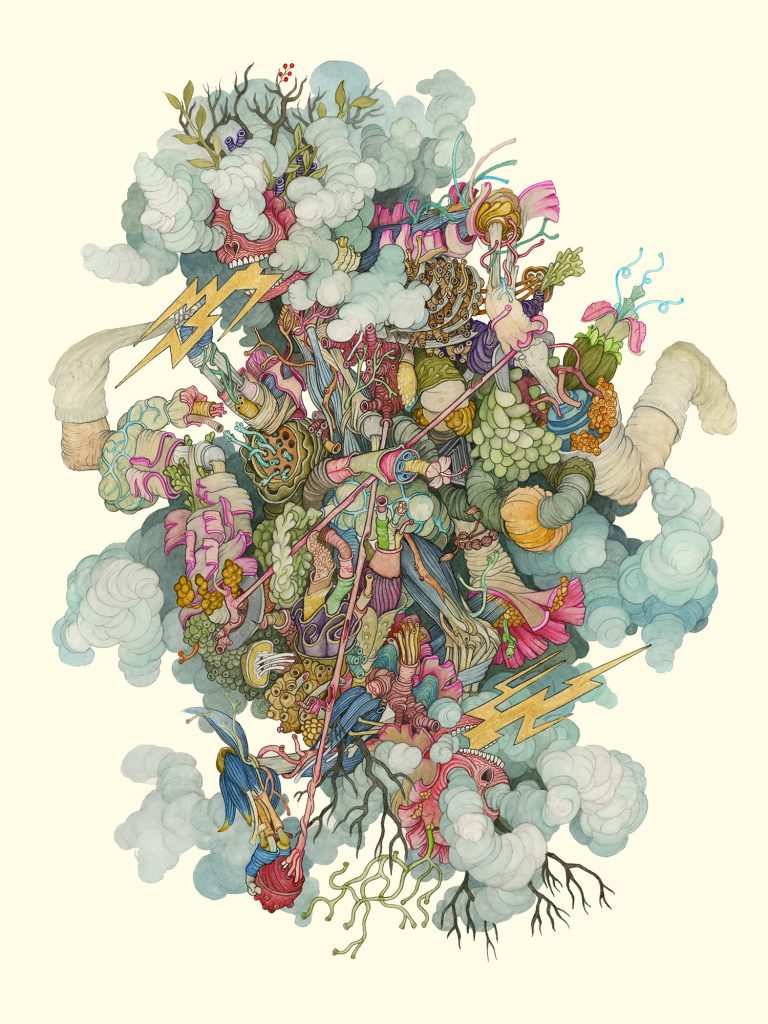
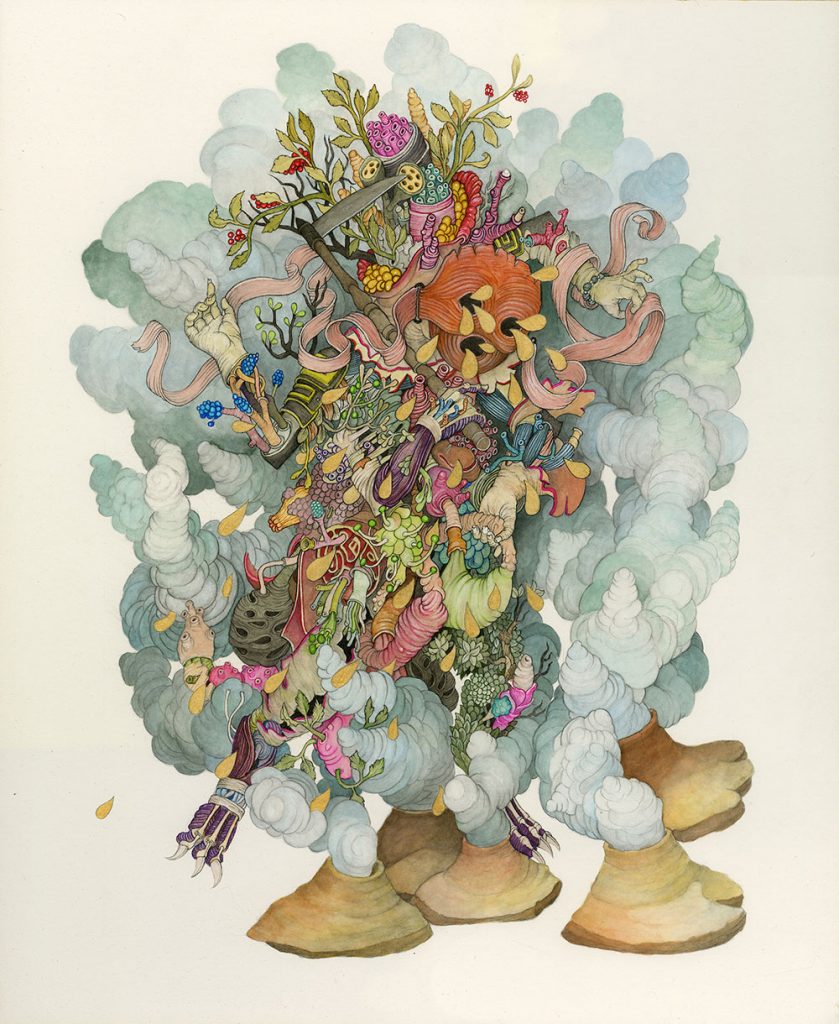
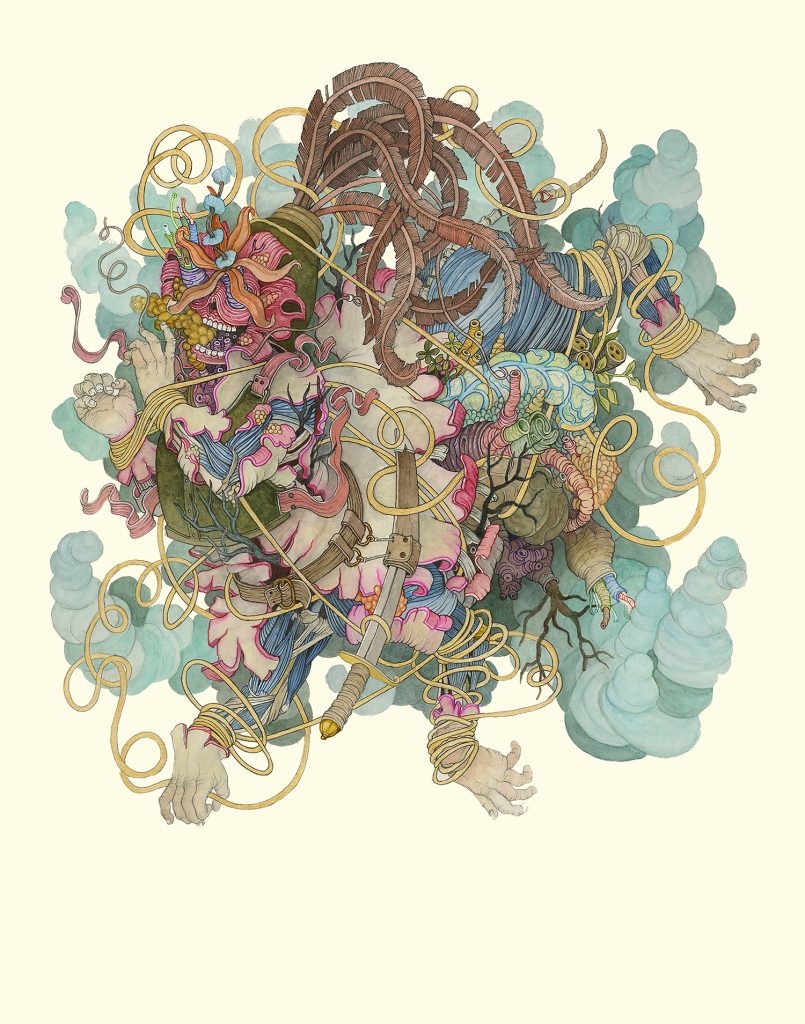
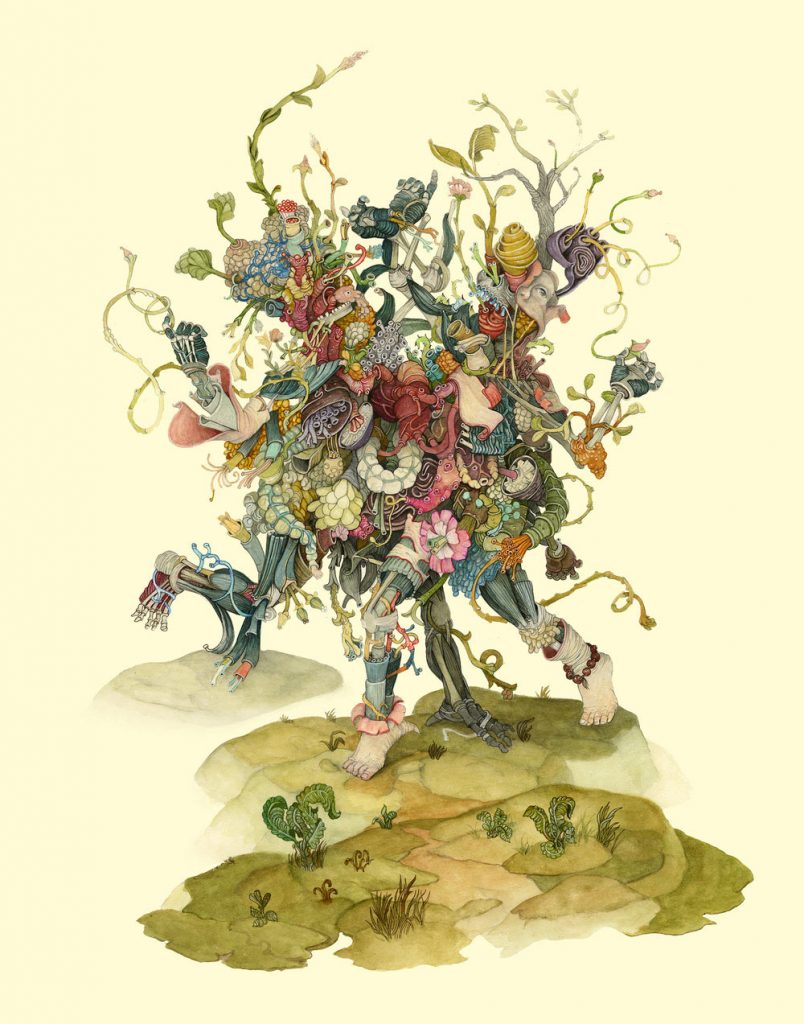

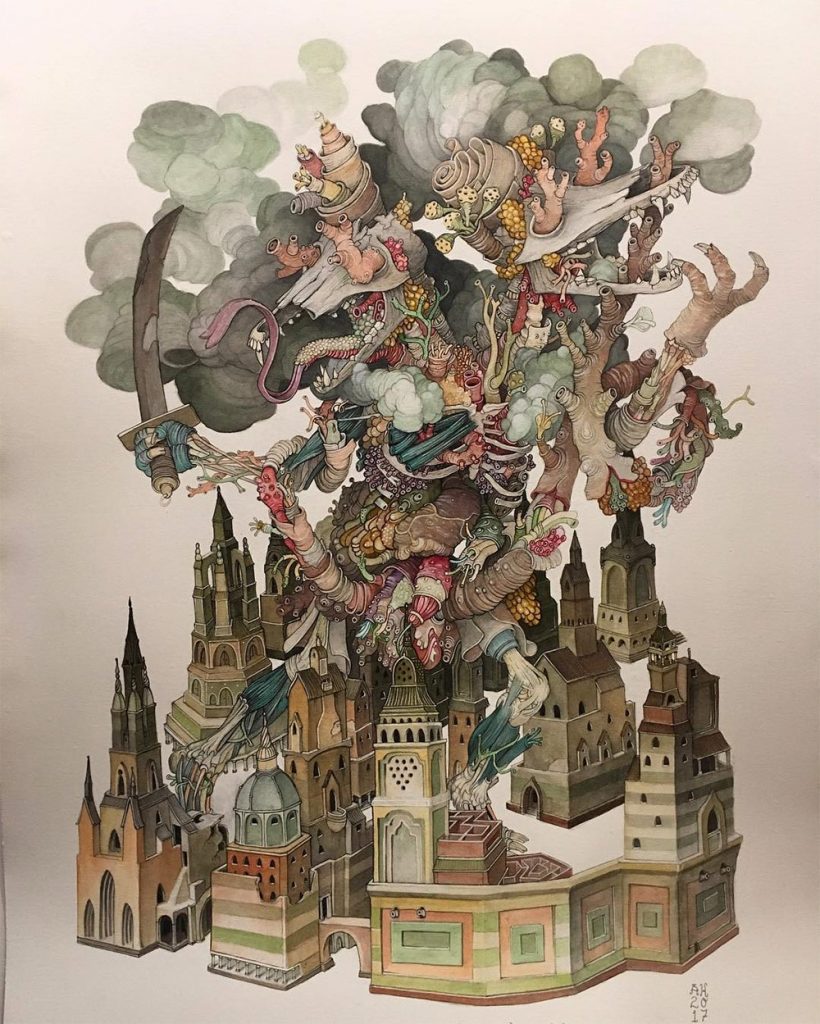
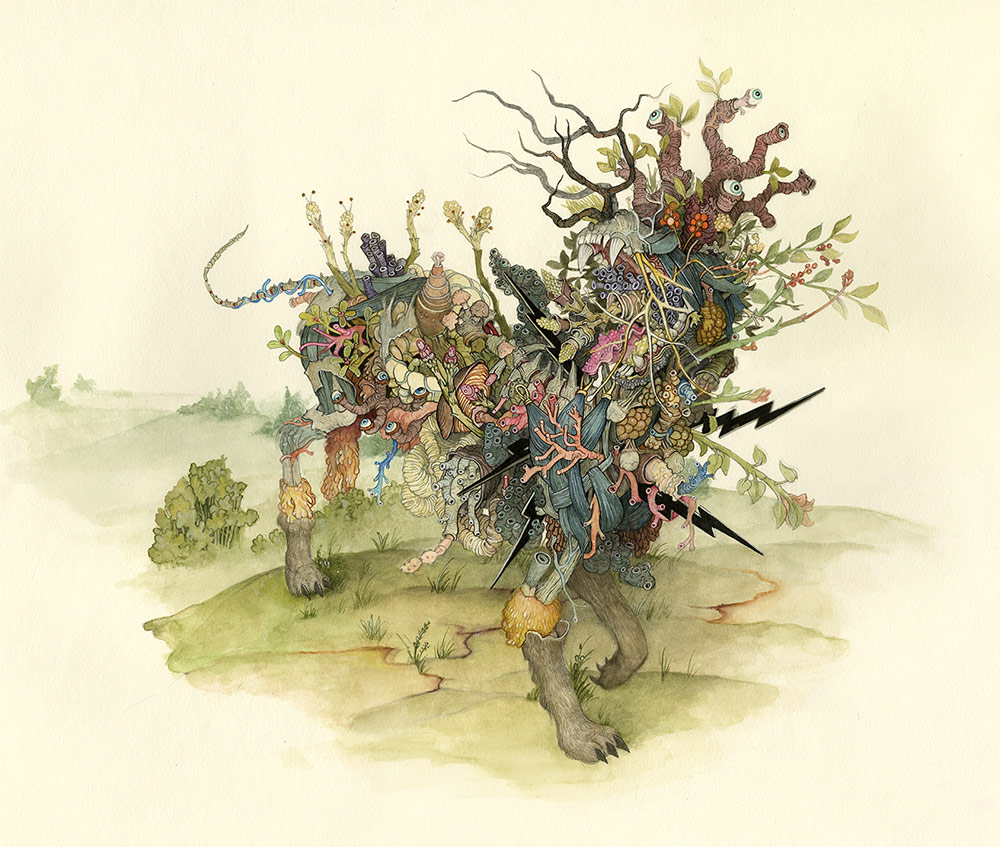
Wildlife Intertwine in Finely Rendered Mythological Worlds by Lauren Marx
December 11, 2019 Laura Staugaitis
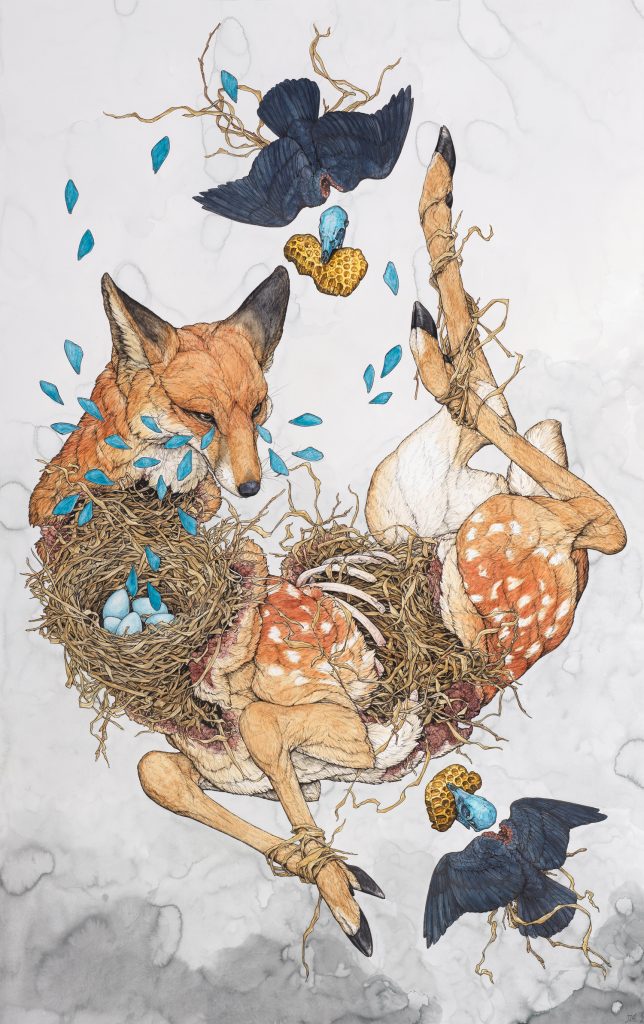
“Offerings” (2019), Pen, watercolor, ink, gel pen and colored pencil on paper. 26.75 x 42.5 inches
Sinuous, intertwined wildlife bridge worlds of the living and the dead in Lauren Marx’s intricate multi- media work. Twisting fox heads, disemboweled deer, and lambs bursting with flowers and birds are rendered with watercolor, ink, pen, and colored pencil. Marx often places her animal compositions on semi-abstract backgrounds, awash with grey tones that give a sense of weightlessness to the dense drawings by evoking fog or clouds.
The artist, who resides in her hometown of Saint Louis, Missouri, cites frequent trips to the Saint Louis Zoo, biology classes, and National Geographic television shows as cultivating her lifelong interest in animals. Her latest body of work debuts December 14, 2019, at Corey Helford Gallery. The show, titled Chimera, is an evolution from her previous pieces, combining multiple animals into each artwork to combine their symbolic meanings.
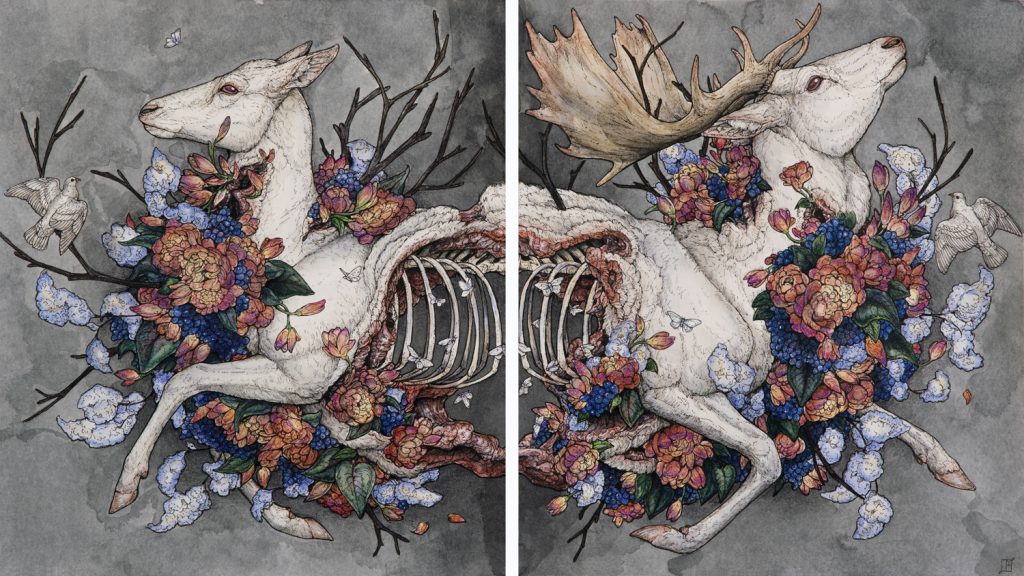
“From Our Flesh” diptych (2015), Pen, ink, colored pencil, graphite, and gel pen, 17.75 x 10 inches
“Chimera further explores my concepts of fauna representations of emotions, personal mental health, family, and self,” Marx shares in a statement. “I am creating a mythological world, centered around North American flora and fauna, to better expresses my image of who I am, how I am perceived, my struggles with mental health, and to explore self-healing.”
Marx studied Fine Art at Webster University and draws inspiration from zoology, mythology, scientific illustration, and Northern Renaissance themes. The artist shares with Colossal that in 2020 she wants to continue to challenge herself technically and conceptually, and that works in the Chimera show brought her practice to new levels in terms of scale and complexity.
See Chimera through January 18, 2020, at Corey Helford Gallery in Los Angeles, and explore more of Marx’s intricate illustrative artwork on Instagram. The artist also offers prints and stickers on Etsy.
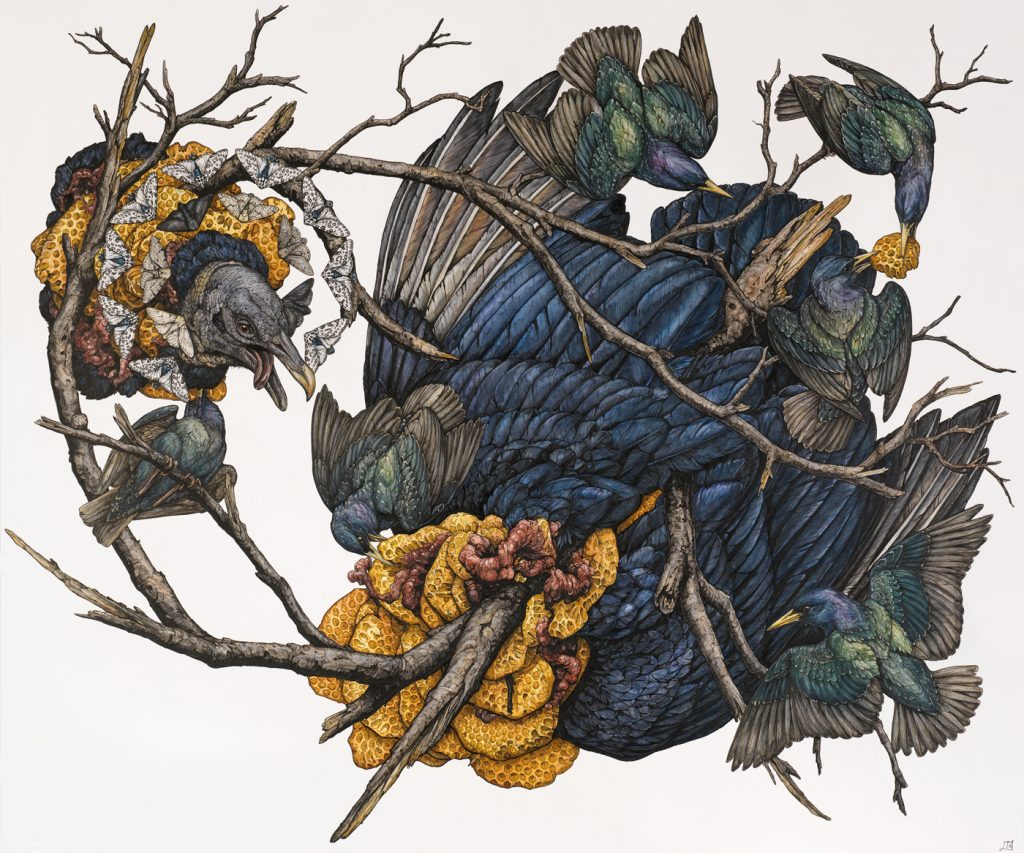
“Honey” (2019) Pen, watercolor, ink gel pen, gouache and colored pencil on mixed media paper, 31 x 37.25 inches
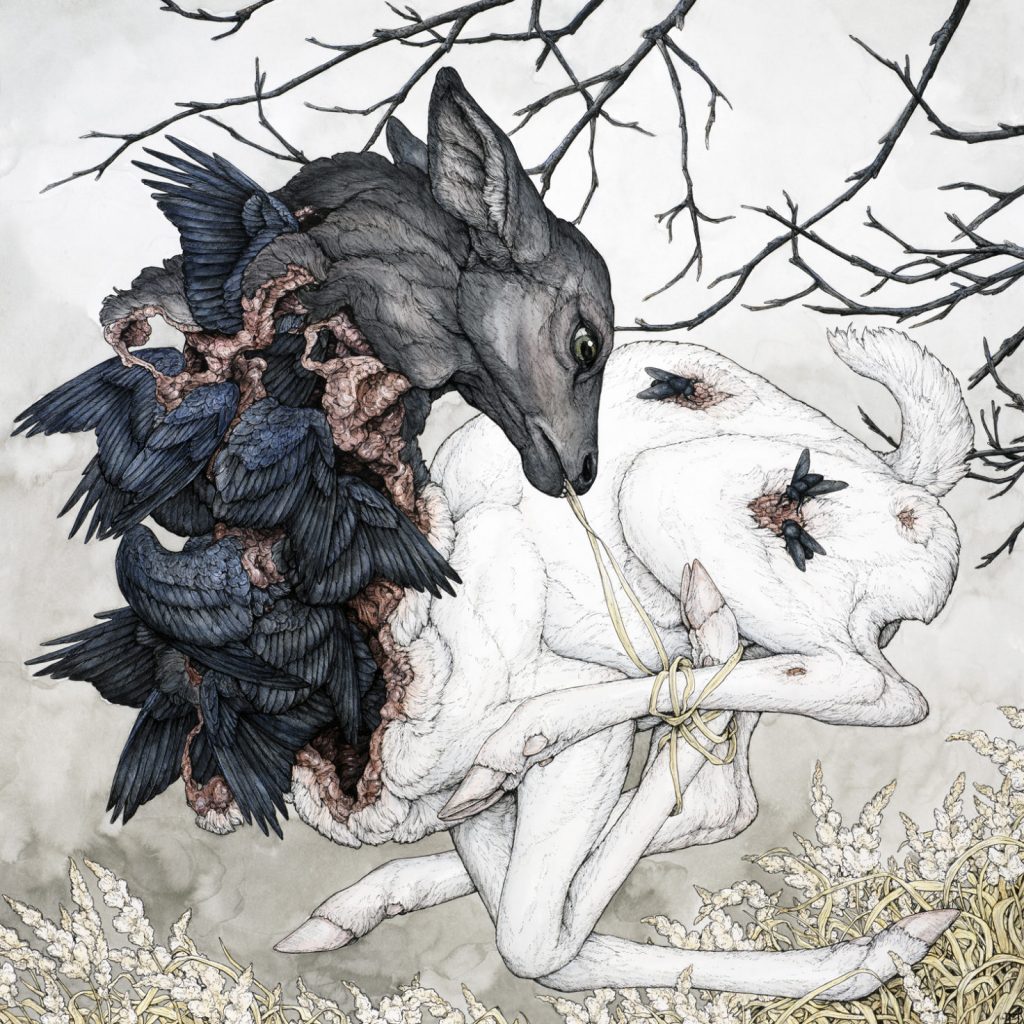
“Self-inflicted” (2016), Pen, ink, graphite, colored pencil, and gel pen on paper, 20 x 20 inches
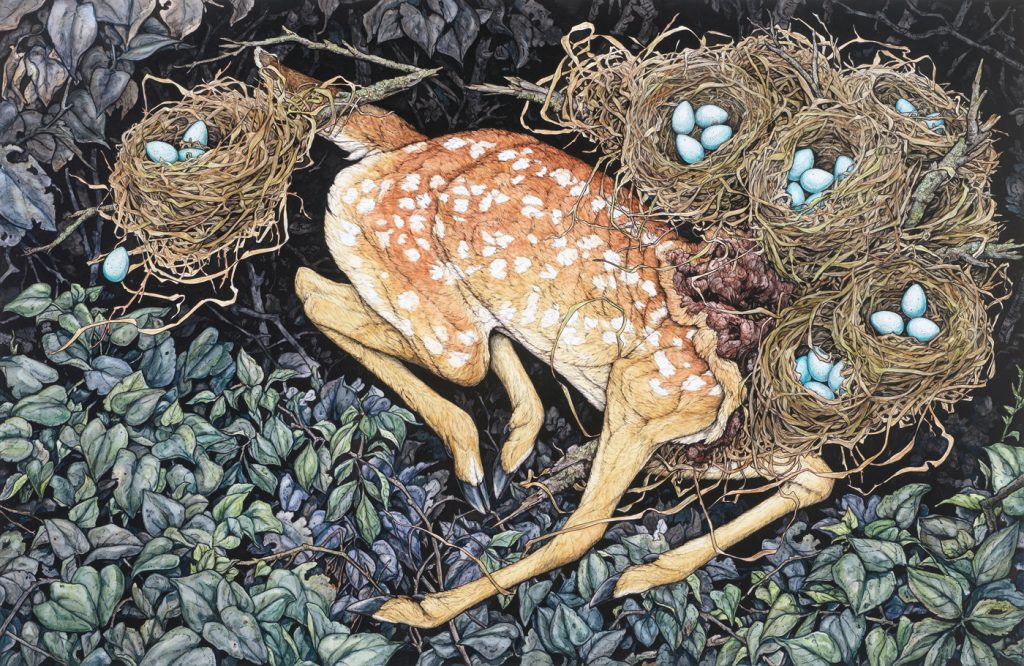
“Nested Fawn” (2019), Pen, watercolor, ink, gel pen, gouache, and colored pencil on mixed media paper, 25.75 x 40 inches
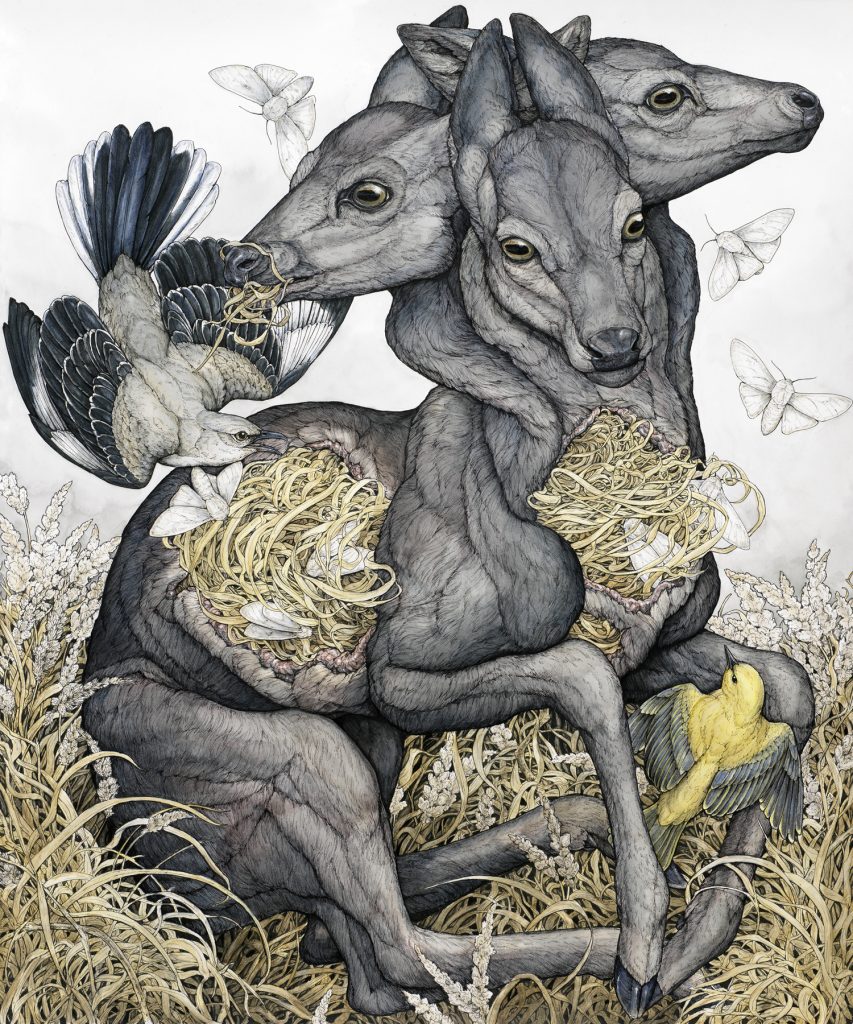
“The First” (2016), Pen, ink, graphite, colored pencil, and gel pen on paper, 20 x 24 inches
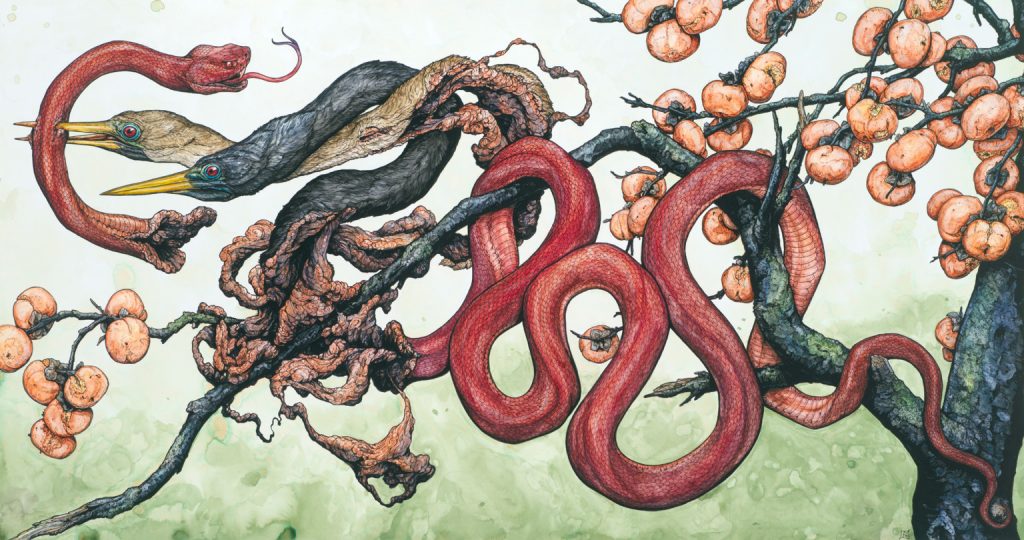
“Snake-Bird” (2019), Pen, watercolor, ink, gel pen and colored pencil on mixed media paper 20 x 38 inches
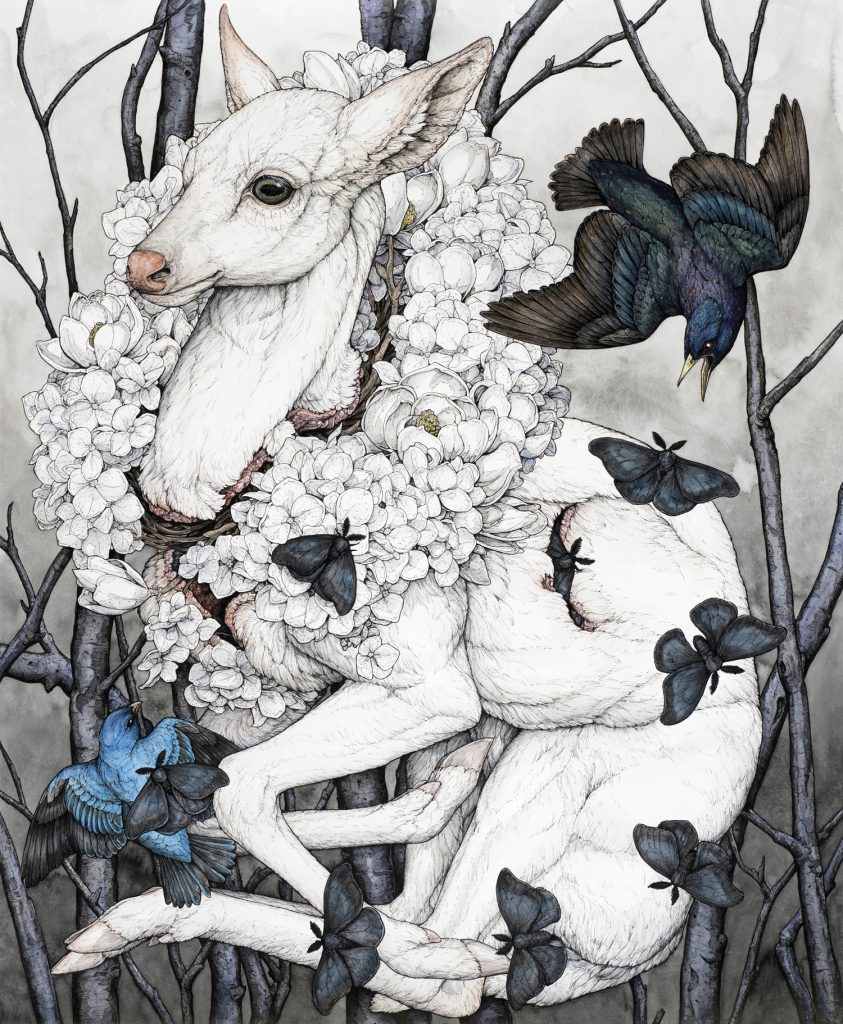
“The Second” (2016), Pen, ink, graphite, colored pencil, gel pen, and acrylic on paper, 20 x 24 inches
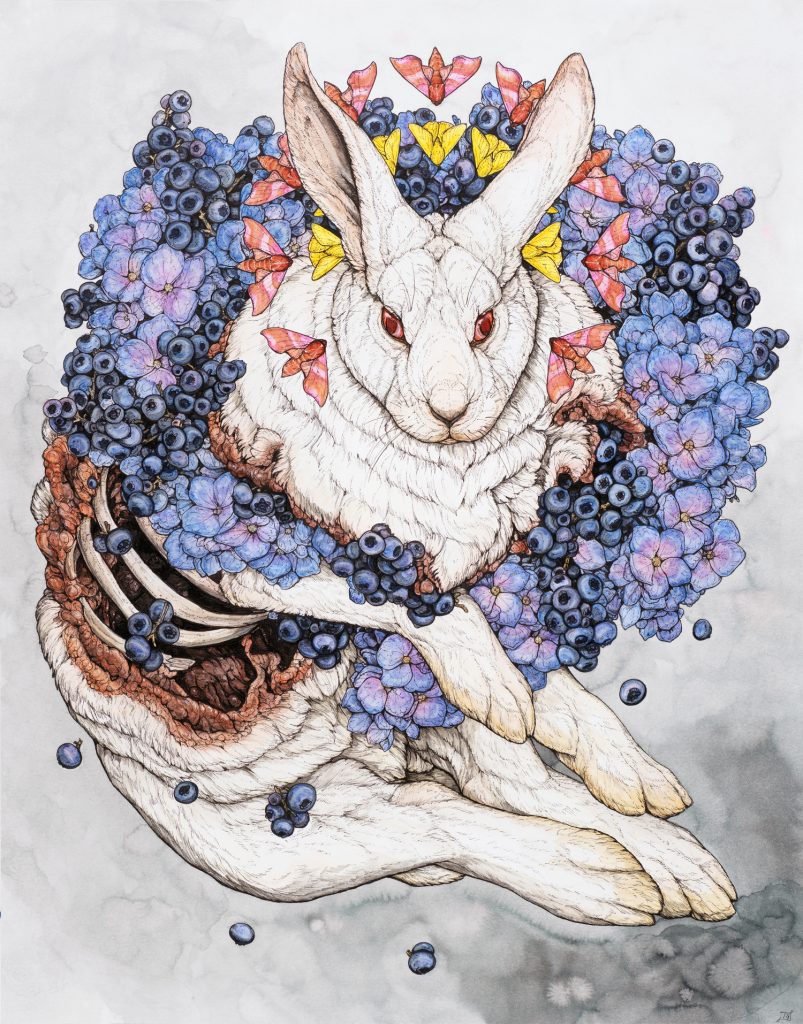
“Lovely” (2018), Pen, watercolor, ink, colored pencil, gel pen, and graphite on paper, 17.5 x 22 inches
Leave a Reply